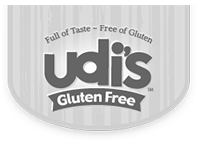Gluten Free
What does following a gluten-free diet mean? That you're embarking on an easy diet with a wide range of health-promoting effects. Instead of dwelling on what you’re giving up, consider that you’re going to enjoy a whole new world of delicious food options to meet your special dietary needs. You’ll be eating seasonally, choosing more fresh fruits and vegetables, focusing on meats, seafood, poultry, legumes, lentils, corn, and rice, and discovering fascinating ancient grains such as quinoa, amaranth, and millet. You’ll be able to eat potatoes, eggs, most cheeses, even chocolate (!)—and enjoy them without guilt because you’ll be taking good care of your body. In fact, you’ll probably end up eating—and feeling—better than ever!
Visit this page for more information about living Gluten Free
---
We carry a large variety of gluten free items, the brands listed below represent just some of the offerings we carry












Raw Foods
“Raw” is all the rage these days, but what does it mean to eat raw? And is it possible to get enough protein and other nutrients while following a raw diet?
Raw foods are those that have not been heated above 108°F to 118°F
Raw, defined
Most raw foodists eat only plant-based (vegan) foods, including vegetables, fruits, nuts, seeds, legumes, and seaweed. Raw foods are those that have not been heated above 108°F to 118°F, depending on who you talk to. The logic behind this is that many of the nutrients in foods are extremely sensitive to heat. This is especially true of the water-soluble vitamins, like the B-vitamins, folate, and vitamin C. As Katie McDonald, a raw food chef and certified Holistic Health Coach in Rhode Island puts it, “The more you do to a food, the less it does for you.”
Raw food advocates also look to the enzyme content of raw foods, saying that cooking destroys delicate enzymes that could otherwise go toward improving the digestion of the foods you’re eating.
---
In addition to our always fresh produce, we carry many more raw foods throughout our stores. Look for these brands and our Raw Foods section for more.



More Diets
- By Suzanne Dixon, MPH, MS, RD
For Beating Hypertension, Yogurt May Be Next Superfood
According to the Centers for Disease Control and Prevention, hypertension (high blood pressure) affects one of every three adults in the United States and is implicated in nearly half of all heart disease. It’s not all doom and gloom, however. Along with sensible steps, such as maintaining a healthy weight and getting regular exercise, eating yogurt may be one of the smartest things you can do to keep high blood pressure at bay.
Try nonfat Greek yogurt in place of sour cream and butter on a baked potato
Tracking the effects of yogurt
Researchers followed approximately 2,000 adults for 15 years, periodically collecting information about their diets, and tracking their blood pressure numbers over time. None of the study participants had high blood pressure at the start of the study, and those who regularly consumed yogurt were more likely to avoid hypertension in the future as well.
Participants who averaged at least one 6-ounce serving of low-fat yogurt every three days were 31% less likely to develop high blood pressure. They also experienced a slower increase in systolic blood pressure—the top number—over time. Nearly all adults experience some rise in blood pressure with age; this study suggests eating yogurt may blunt that tendency.
Uncontrolled high systolic pressure increases the risk of stroke, heart attack, congestive heart failure, kidney damage, and blindness. If adding yogurt into the diet can keep this number in the healthy range, that is good news indeed.
Putting it in perspective
The research was presented at the American Heart Association's High Blood Pressure Research 2012 Scientific Sessions. Study findings presented at medical conferences have not yet undergone the “peer review” process, so the results are considered preliminary at this point.
Still, the results make sense. The study agrees with other research, which supports an important role for low-fat dairy and other calcium-rich foods in maintaining normal blood pressure. Despina Hyde, a registered dietitian at New York University Langone Medical Center notes, “Yogurt is a good source of calcium, and many studies have shown that calcium can help keep blood pressure levels under control.”
Other minerals also may contribute to yogurt’s positive blood pressure effects. It is a good source of potassium and magnesium and both of these nutrients have been shown to help maintain blood pressure in the healthy range. Another interesting possibility is that probiotics—the healthy bacteria found in fermented foods—may help regulate blood pressure. Though research is preliminary, and researchers aren’t yet sure which strains of bacteria may be most beneficial for lowering blood pressure, yogurt is one way to get more of these potentially health-promoting microbes into your body.
Getting your yogurt fix
Keep the following in mind as you add yogurt to your nutrition plan:
- Go low. Stick to low-fat or non-fat varieties. Few need the extra calories and saturated fat found in full-fat varieties.
- Substitute smartly. Try nonfat Greek yogurt in place of sour cream and butter on a baked potato, or to make a tuna sandwich.
- Make your own. Instead of presweetened varieties, start with plain yogurt and add your own fruit and a little swirl of honey for flavor, to minimize sugar.
- DASH to health. Try the DASH—Dietary Approaches to Stop Hypertension—diet. You can find free information about this nutrition plan online, or in the health section of your local library.
(Abstract 188; American Heart Association High Blood Pressure Research Scientific Sessions: September 21, 2012; Washington, DC)












